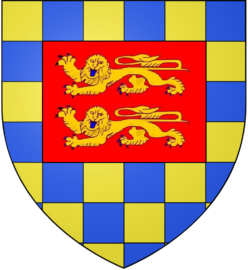During the conquest of England by William the Conqueror in 1066, the Norman fleet with about 7000 men left Saint-Valery-sur-Somme in Picardy to land at Pevensey. The famous Hastings Battle followed on 14 October of the same year and the bastard became the conqueror in order to be crown king of England in London in Westminster Abbey at Christmas. The conquerors of the England were rewarded by their Duke of Domains without any Measure with their original fiefdom, forming the new English aristocracy. These are the knights and their servants who helped make England a great nation. Amongst the new king’s men at arms were many lords of Talou around William de Warenne.
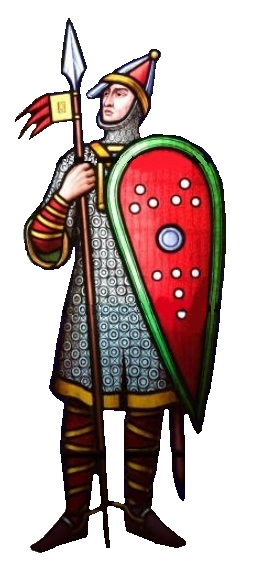
Stained-glass window from XIXth C. in the chapel of Southover Church in Lewes (Sussex, England) representing William de Warenne in armour
Who were they ? To identify them, we are in possession of two principal sources :
– The oldest list (of names) was engraved on the west wall of the nave of the church of Dives-sur-Mer in Calvados in 1862, above the entrance door and consists of 433 names. Those mentioned below are extracted from this list.
– The second list is an engraved brass plaque raised in 1931 in the chapel of the Falaise Castle (the birth place of William the Conqueror).
Where these comrades-in-arms bear toponymic surnames, it should be a simple task to identify their place of origin. In reality however, it is made difficult if not impossible by the existence of several villages of the same name throughout Normandy :
– ARQUES : William d’Arques and Osberne d’Arques (See The castles of Talou)
– AUMALE : Eudes, seigneur d’Aumale, comte de Champagne and Robert d’Aumale
– AUVILLIERS : A gentleman of Autvilliers, but there is another Autvilliers near Pont-l’Evêque. The first is the more plausible because he was the vassal of the Mortemer / Mortimer family.
– BIVILLE : William de Biville and Honfroi de Biville. There is another Biville that of Biville-sur-Mer between Dieppe and Eu.
– BLANGY : Guimond de Blangi. There is another Blangy that of Blangy-sur-Bresle between Eu and Aumale.
– BULLY : Roger de Busli (DSM). Il possédait de larges domaines dans le Yorshire où il établit sa résidence principale à Tickhill Castle à proximité du château de Conisbrought construit par Guillaume de Varenne et ses descendants. Il était en famille avec les comtes d’Eu (voir rubrique La famille Varenne / Warren).

– BURES(-en-Bray) : Michael de Bures. There are two other « Bures » in Calvados (see The Castles of Talou). In an English knight of the name of at the border between Suffolk and Essex, there is a town called Bures. In 1302, we see an English knight called Robert de Bures (1250-1331), a monument to whom can still be seen in Acton church in Suffolk.
– DRINCOURT (today Neufchâtel-en-Bray) : A knight present and killed at the battle of Hastings (see The castles of Talou).
– ENVERMEU : Renier de Brimou. Brimou was the old form of the name Envermeu in the XIth C. But Hugho and Turold d’Envermeu don’t appear on either list.
– EU : William de Eu and Osborn de Eu with their brother the count d’Eu. The latter received the castle at Battle in Sussex. A descendant of the counts d’Eu and Pembroke undertook the conquest of Ireland.
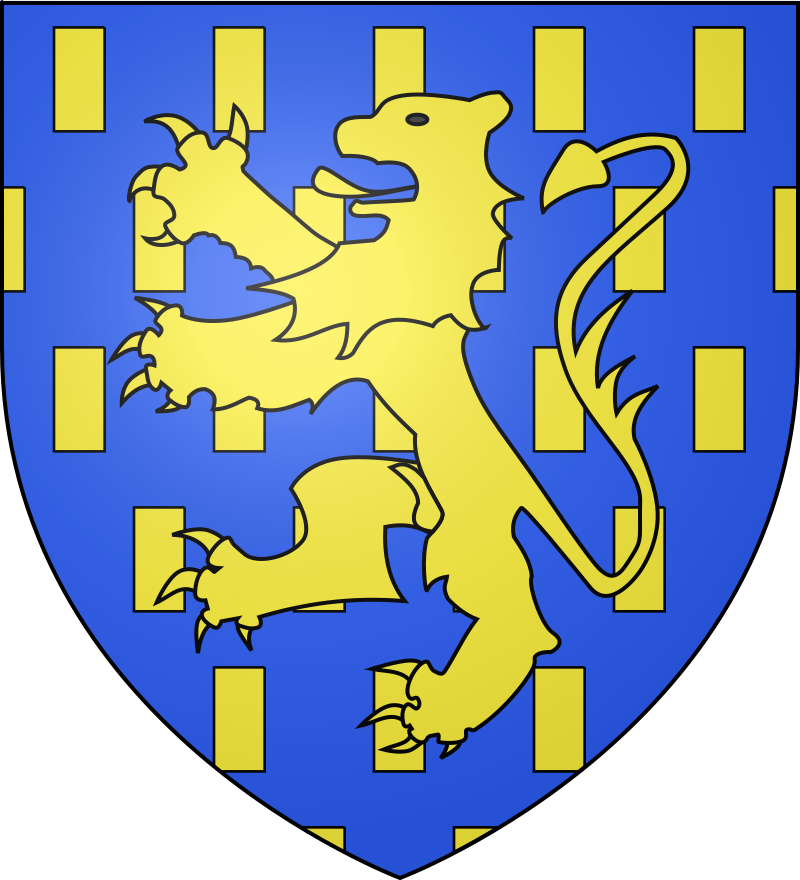
Le blason des comtes d’Eu se décline ainsi : D’azur, au lion d’or, l’écu semé de billettes d’or
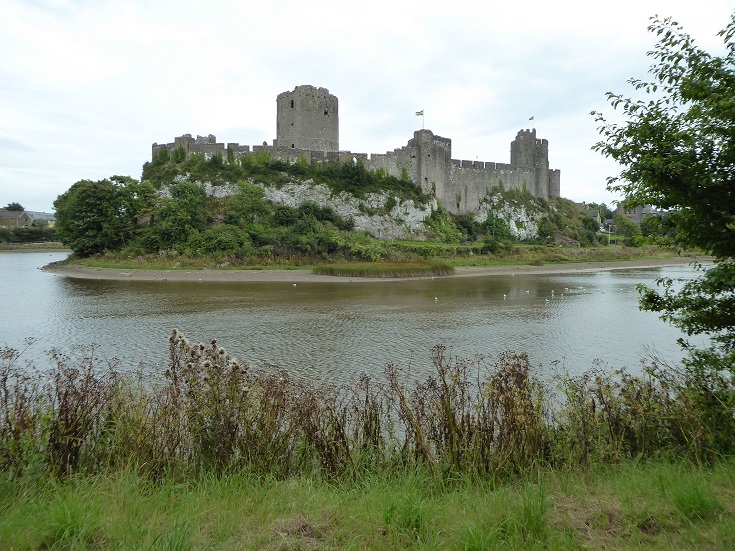
– FRESLES : Richard de Fresle (DSM)
– GRANDCOURT : Gautier de Grandcourt (DSM)
– HAUTOT-SUR-MER : Hugue de Hotot (DSM). There are several Hautot in Normandy. This one probably refers to a commune south of Dieppe where there are ruins of a fortified castle (see The castles of Talou).
– HODENG : Hugue de Hodeng (DSM). Several such places are mentioned.
– LONGUEVILLE-SUR-SCIE : Gautier Giffard ( DSM/CF) and his brothers Osborne and Bérenger. His descendants in England took the name CLARE. The lord of Longueville became the count of Buckingham. Longueville-sur-Scie has an important castle with a commemorative plaque remembering Gauthier Giffard (see The castles of Talou)..

en souvenir de Gauthier Giffard
– LUCY : Hugue de Laci (DSM), Gautier de Lacy and Ibert de Lacy (DSM/CF). There is Lacié in Calvados and Lucé in the Orne.
– MASSY : Hugue de Maci (DSM), Hugue de Macey (CF). Massy in Pays de Bray or perhaps Macey in the Manche.
– MONCHAUX : Guillaume de Monceaux (DSM/CF). A Monceaux exists in Calvados. In Monchaux-Soreng in the Bresle valley (north Normandy), there is a ruined castle (see The castles of Talou).
– MORTEMER / MORTIMER :
Raoul de Mortemer and his son Hugh de Mortemer. Their ancestor Roger de Mortemer participated in the battle of Mortemer(-sur-Eaulne) in 1054. After this, thanks to his difference with the Duke of Normandy, the Mortemer castle was granted to his brother from Bellencombre (As professor David Bates has observed, all rulers in this early medieval period were unrestrained by constitutional or legal limitations over the way they behaved. They wielded immense arbitrary power and as seemingly in this exemple, could dispense favour and disfavour at will). Raoul de Mortemer was the brother of William de Warenne.

Les armes des Mortemer se déclinent ainsi : Burelé d’or et d’azur, au chef tiercé en pal, le premier tranché, le troisième taillé des mêmes, le deuxième d’azur en pal d’or, un écusson d’argent brochant en cœur.
– MUCHEDENT : Gautier de Mucedent (DSM).
– NOYERS (LES) : Guillaume de Noyers (DSM). Guillaume de Noyers. Toponyme also found in the Eure.
– PIERREPONT : Geoffroi and Renaud de Pierrepont (DSM), Geoffroi and Robert de Pierrepont (CF). There is a Pierrepont in Cotentin, but this Pierrepont is most probably a hamlet in the commune of Grandcourt.
– ROSAY : Vauquelin de Rosai (DSM) being Rosay, a commune near Bellencombre or hamlet of the communes of Haussez and Ménerval in Pays de Bray.
– SAINT-LEGER : Robert de Saint-Léger of Saint-Léger-aux-Bois in the north of Seine-Maritime or Saint-Léger near Avranches in the south of Normandy
– SAINT-MARTIN : Perhaps Saint-Martin-le-Gaillard in the Yères valley near EU. A seal of Jeanne de Saint-Martin-le-Gaillard was discovered in the Bellencombre castle. She was related to the family Hautot and Estouteville of Torcy (see The castles of Talou).
– SAINT-OUEN : Bernard de Saint-Ouen (Bernardus de Andoeno Sancto) is this Saint-Ouen near Arques or Saint-Ouen-sous-Bailly near Envermeu or another ?
– SAINT-SAENS : Lambert de Saint-Saëns does not appear on any list of William the Conquerors companions. He was descended from a niece of the duchess of Gonnor or the same title as William de Warenne, Raoul de Mortemer and the sire of Saint-Martin who all participated in the conquest of England. However, we know a lord of Saint-Segus who could be likened to Saint-Saire in the Pays de Bray. Dilemma ! Other names are sometimes advanced, but have not been noted on either list, as is the case for Geoffroy de Flocques, Robert de Torcy… (see The castles of Talou).

– SEPT-MEULES : Guillaume de Sept-Meules (DSM)
– TALBOT : Guillaume Talbot and their sons Geoffroi and Richard Talbot. The Talbots possessed serious assets in the north of Seine-Maritime (Guilmécourt, Sangroy, Touffreville-sur-Eu, Buchy, Beaubec…). Geoffroy Talbot held lands in Essex in 1086 (Domesday Book). His brother Richard Talbot held lands in Bedford under William Giffard. In south Wales, there is a town names Port Talbot.
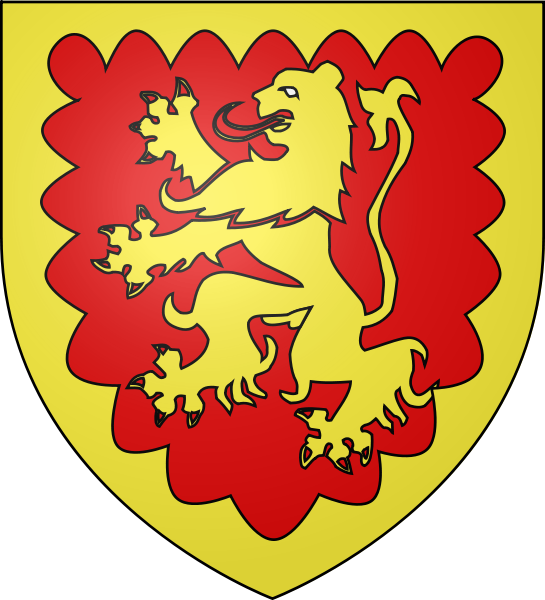
– Les armes des Talbot : De gueules à un lion d’or et une bordure engrêlée de même
– WANCHY : Osborne de Wanci and Hughe de Wanci. They accompagnied William to England. Both held lands in Suffolk in 1086 (Domesday Book), Hughe also had a tenancy in Norfolk under William de Warenne, as witnessed in a charter of Castle Acre at the priory of Castle Acre (voir rubrique Les châteaux forts du Talou). Les armes de cette famille comportent des gants du fait que les Wauncy étaient les grands fauconniers des Earls de Warren. Elles sont variables suivant les époques : De gueule, à six gants d’argent / De gueule, à six mains droites en 3,2,1 / De gueule, à trois gants d’argent de mains droites pointant vers le bas. On les retrouve en Angleterre sur un vitrail de l’église de West Barsham (Norfolk). Les Wauncy avaient aussi des domaines à Denver (Norfolk) et à Depeden (Suffolk).
D’autres noms sont parfois avancés, mais n’ont été relevés sur aucune des deux listes, c’est le cas pour Geoffroy de Flocques, Robert de Torcy…
Sources : Gaudefroy Ghislain. D’où venaient ces chevaliers qui ont suivi Guillaume lors de la conquête de l’Angleterre ? Connaissance de Dieppe et de sa région, Editons Bertout, Luneray, n°59, octobre 1989, pp.14-19 et n°60, novembre, pp. 4-9.

à Hastings en 1066
